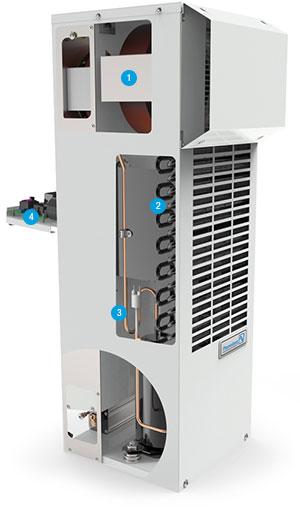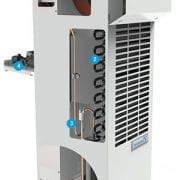Why Pfannenberg’s Cooling Units Do Not Need A Filter
Pfannenberg’s ‘service-friendly’ DTS cooling units provide effective cooling for tough industrial or outdoor applications. Their closed-loop designs ensure that ambient air, dust, and humidity are not passed to the interior of the enclosure, thereby keeping sensitive and critical electronics safe from contamination and in prime operating condition.
Pfannenberg’s DTS Cooling Units filter-less design reduces the amount of required maintenance needed for operation in dirty environments. Indeed, if a dirty filter is not cleaned or replaced, it can become clogged which severely limits its efficiency and result in poor performance.
Filter-Less Design
 High Airflow Backward Curve Impeller Fan
High Airflow Backward Curve Impeller Fan
Provides high airflow in a long lasting, single bearing design. Higher airflow pushes dirt through wider fin spacing allowing for less clogging which avoids system failure.
- Large Fin Spacing
Large condenser fin spacing allow for longer maintenance periods, even without an additional Nano coating. They are less susceptible to clogging from dirt buildup which can cause the unit to work harder and hamper efficiency. - Corrosion Protection
The DTS Outdoor and wash-down units have a special coating on pipes and coils on the ambient side of the unit to provide maximum protection from saltwater, sour gas, and other corrosive substances. - Self-Protected Electronics
Our unit is uniquely designed to protect itself in NEMA 3R, 4, and 4X environments. An example of this is the location of our control electronics within our dry, cool interior circuit.
How to Avoid System Failure
As with any unit located in a dirty environment, the components around the external air circuit require periodic cleaning. To avoid any critical component failure, follow the 3 simple steps below to help ensure your enclosure cooling units stay up running:
- STEP 1: Make Sure your Condenser Coils are Clean
When dirt, dust or debris builds up on your condenser coils, it can have a major effect on the performance of your cooling unit. - STEP 2: Check your Fan Motors and Inside/Outside Electrical Components
The fan motor and fan blades need to be inspected to determine wear and damage. Also make sure electrical components aren’t damaged or loose. - STEP 3: Set your Unit to the Recommended Proper Temperature
Pfannenberg recommends the dip-switches on the control board to 95°F/35°C in the factory.
All maintenance should be performed by qualified personnel, following all safety procedures. To help you perform your preventative maintenance, Pfannenberg realized a simple video following the 3 above steps: Watch the Full Video Now!





